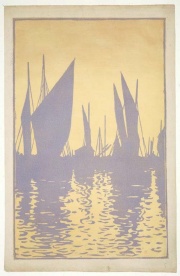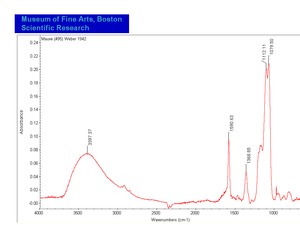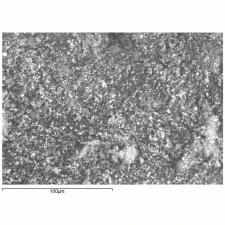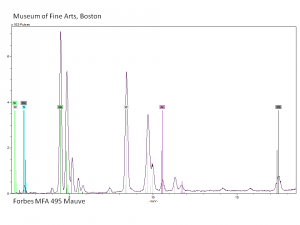Difference between revisions of "Mauve"
Jump to navigation
Jump to search
(username removed) |
|||
| (8 intermediate revisions by 5 users not shown) | |||
| Line 1: | Line 1: | ||
| − | [[File:1998.34-SC20662.jpg|thumb|]] | + | [[File:1998.34-SC20662.jpg|thumb|Woodcut in mauve and yellow; MFA# 1998.34]] |
== Description == | == Description == | ||
| − | The first synthetic basic dye. The pale purple color was patented in August 1856 by William Perkin, a Scottish chemist. Mauve is an aniline based dye that is composed of amino-phenylamino-p-tolyl ditolazonium sulfate. It was synthesized from coal-tar when Perkin treated [ | + | The first synthetic basic dye. The pale purple color was patented in August 1856 by William Perkin, a Scottish chemist. Mauve is an aniline based dye that is composed of amino-phenylamino-p-tolyl ditolazonium sulfate. It was synthesized from coal-tar when Perkin treated [[aniline|aniline]] with [[sulfuric%20acid|sulfuric acid]] and [[potassium%20dichromate|potassium dichromate]]. Mauve is not lightfast and but is still occasionally used in some watercolor paints. |
| − | |||
== Synonyms and Related Terms == | == Synonyms and Related Terms == | ||
| − | aniline violet; CI 50245; mauveine; Malven (Deut.); mauve (Fr., Ned.); | + | aniline violet; CI 50245; mauveine; Malven (Deut.); mauve (Fr., Ned.); mauvéïne (Fr.); pourpre d'aniline (Fr.); violetto anilina (It.); malva (Port.); Perkin's violet; Perkin's purple; aniline purple |
| − | + | [[[SliderGallery rightalign|Mauve (bottle 495) Weber 1942.TIF~FTIR (MFA)|f495sem.jpg~SEM|f495edsbw.jpg~EDS|Slide10 F495.PNG~XRF]]] | |
| − | + | == Physical and Chemical Properties == | |
| − | + | * Composition = C27H25N4(SO4)1/2 | |
| − | + | ==Additional Images== | |
| − | + | <gallery> | |
| − | + | File:495 mauve.jpg|thumb|Mauve | |
| − | + | File:mauve C100x.jpg|thumb|Mauve | |
| − | [[[SliderGallery rightalign| | ||
| − | |||
| − | == | ||
| − | |||
| − | |||
| − | |||
| − | == Additional Images == | ||
| − | |||
| − | <gallery> | ||
| − | File:mauve C100x.jpg|Mauve | ||
</gallery> | </gallery> | ||
| + | == Resources and Citations == | ||
| − | + | * R. J. Gettens, G.L. Stout, ''Painting Materials, A Short Encyclopaedia'', Dover Publications, New York, 1966 | |
| − | |||
| − | * | ||
| − | * | + | * Reed Kay, ''The Painter's Guide To Studio Methods and Materials'', Prentice-Hall, Inc., Englewood Cliffs, NJ, 1983 |
| − | * | + | * Ralph Mayer, ''A Dictionary of Art Terms and Techniques'', Harper and Row Publishers, New York, 1969 (also 1945 printing) |
| − | * | + | * Rosalie Rosso King, ''Textile Identification, Conservation, and Preservation'', Noyes Publications, Park Ridge, NJ, 1985 |
| − | * | + | * F. Crace-Calvert, ''Dyeing and Calico Printing'', Palmer & Howe, London, 1876 |
| − | * | + | * A.Scharff, 'Synthetic dyestuffs for textiles and their fastness to washing', ''ICOM-CC Preprints'' Lyon, Getty Conservation Institute, Los Angeles, 1999 |
* Art and Architecture Thesaurus Online, http://www.getty.edu/research/tools/vocabulary/aat/, J. Paul Getty Trust, Los Angeles, 2000 | * Art and Architecture Thesaurus Online, http://www.getty.edu/research/tools/vocabulary/aat/, J. Paul Getty Trust, Los Angeles, 2000 | ||
Latest revision as of 09:53, 30 October 2020
Description
The first synthetic basic dye. The pale purple color was patented in August 1856 by William Perkin, a Scottish chemist. Mauve is an aniline based dye that is composed of amino-phenylamino-p-tolyl ditolazonium sulfate. It was synthesized from coal-tar when Perkin treated Aniline with Sulfuric acid and Potassium dichromate. Mauve is not lightfast and but is still occasionally used in some watercolor paints.
Synonyms and Related Terms
aniline violet; CI 50245; mauveine; Malven (Deut.); mauve (Fr., Ned.); mauvéïne (Fr.); pourpre d'aniline (Fr.); violetto anilina (It.); malva (Port.); Perkin's violet; Perkin's purple; aniline purple
Physical and Chemical Properties
- Composition = C27H25N4(SO4)1/2
Additional Images
Resources and Citations
- R. J. Gettens, G.L. Stout, Painting Materials, A Short Encyclopaedia, Dover Publications, New York, 1966
- Reed Kay, The Painter's Guide To Studio Methods and Materials, Prentice-Hall, Inc., Englewood Cliffs, NJ, 1983
- Ralph Mayer, A Dictionary of Art Terms and Techniques, Harper and Row Publishers, New York, 1969 (also 1945 printing)
- Rosalie Rosso King, Textile Identification, Conservation, and Preservation, Noyes Publications, Park Ridge, NJ, 1985
- F. Crace-Calvert, Dyeing and Calico Printing, Palmer & Howe, London, 1876
- A.Scharff, 'Synthetic dyestuffs for textiles and their fastness to washing', ICOM-CC Preprints Lyon, Getty Conservation Institute, Los Angeles, 1999
- Art and Architecture Thesaurus Online, http://www.getty.edu/research/tools/vocabulary/aat/, J. Paul Getty Trust, Los Angeles, 2000






